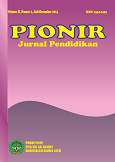THE INFLUENCE OF USING PHET DIGITAL MEDIA ON MATHEMATICS LEARNING OUTCOMES FOR FRACTION MATERIAL FOR CLASS 3 SDN 1 TLOGOTUWUNG
DOI:
https://doi.org/10.22373/2qrs4w63Abstract
This study aims to determine the effect of using PhET digital media on the mathematics learning outcomes of grade 3 students at SDN 1 Tlogotuwung. The basis of this study is the insufficient education achievement of learners, especially the physical learning outcomes, as well as the lack of optimal use of innovative and interactive learning media in the learning process.This research adopts a qualitative approach, specifically utilizing a Pre-Experimental Design framework. The specific design implemented in this study is the One Group Pretest-Posttest model, which involves measuring the same group of participants before and after the intervention. The population targeted in this study consists of all third-grade students enrolled at SDN 1 Tlogotuwung. From this population, the sample was drawn, comprising two sets of data pretest and posttest results each involving 25 students. To gather the required data, a multiple-choice test was employed as the main research instrument, serving to evaluate students' understanding and learning outcomes before and after the use of the intervention. The data analysis methods employed included the normality test also matched pairs t-test. The data indicated a notable difference in students’ educational attainment who used the PhET digital media and those who did not use it. This is proven by the results of the Double-Sided T-Test 0.000 which shows a significance value of less than 0.05. Thus, it may be inferred that utilizing PhET digital media yields a beneficial impact on improving students' mathematical learning outcomes.
Keywords: Learning Outcomes, PhET Digital Media, Mathematics, Fractions
Downloads
Published
Issue
Section
License
Copyright (c) 2025 Wanda Widyasari, Arum Dwi Rahmawati, Novia Rahma Rista Utami Utami

This work is licensed under a Creative Commons Attribution-ShareAlike 4.0 International License.
- Authors retain copyright and grant the journal right of first publication with the work simultaneously licensed under a Creative Commons Attribution License that allows others to share the work with an acknowledgment of the work's authorship and initial publication in this journal.
- Authors are able to enter into separate, additional contractual arrangements for the non-exclusive distribution of the journal's published version of the work (e.g., post it to an institutional repository or publish it in a book), with an acknowledgment of its initial publication in this journal.
- Authors are permitted and encouraged to post their work online (e.g., in institutional repositories or on their website) prior to and during the submission process, as it can lead to productive exchanges, as well as earlier and greater citation of published work (See The Effect of Open Access).

